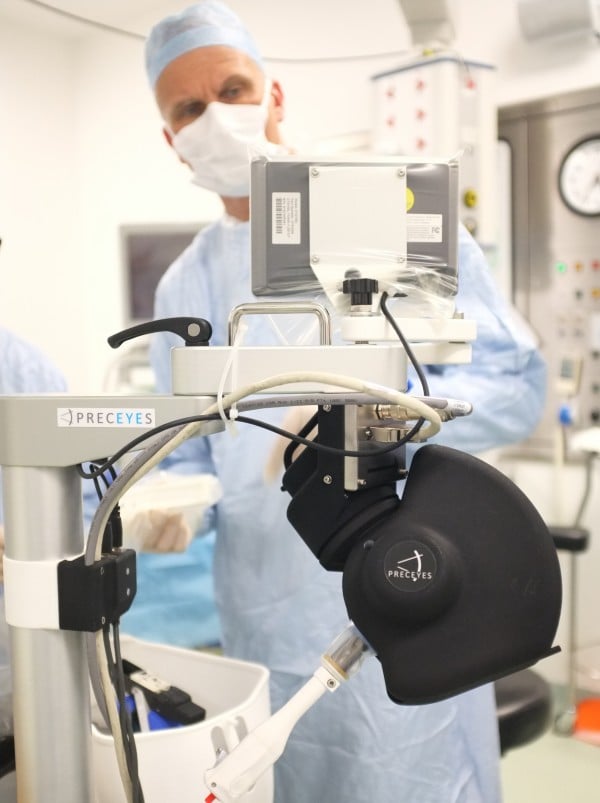
3D printed parts meet traditionally manufactured parts in Preceyes’ first-of-its-kind surgical robot
Thijs Meenink had a challenge both enormous and microscopic: create a solution for eye surgeons to perform procedures at a scale never before attempted — a much, much smaller scale. However, the size of the problem he was addressing was huge: untreatable retinal diseases that affect 50 to 75 million people.
Meenink co-founded Preceyes to develop a new kind of precision robotic solution, one that could both assist surgeons and mitigate the risks of human error in the most, well, precise of surgeries: vitreoretinal procedures that take surgical instruments inside the eye. “These are the most delicate, and the most difficult kind of procedures within eye surgery, and even within microsurgery,” he told us. “The stability and precision, plus the smoothness of using a robot really contribute to the abilities of the surgeon.”
Pioneering a technology based around hardware iterations has traditionally been a costly endeavor. For Preceyes, creating a new generation of ultra-precise, first-of-their-kind surgical robots necessitated a new way of working. “The complete system is totally new. There is no part that was already available; the entire system is built from scratch.” Shapeways would play a key role in bringing it to life.
“I started out experimenting with Shapeways over five years ago. First I made one thing, then a few things per month, and it just kind of snowballed. I soon saw how useful it could become.” As Meenink developed Preceyes’ robots, 3D printing became more than a means of creating parts. Without Shapeways, the robots simply would not exist.
“It started with prototyping — just to hold something and get a feel for its shape and mechanisms. And testing to see if things work like you’d thought. But, when you get more familiar with it, you make real products. And you have a lot of freedom. Now, I think we have 60 products made by Shapeways that are in the robotic system, in nylon, aluminum, and stainless steel. In the beginning you aren’t really familiar with the process and the possibilities. I was expecting to receive parts that were very weak. But that changed: the parts weren’t weak, and tolerances have only gotten better and better. They simply work.”
One of the best illustrations of the power of 3D printing in the robots’ continued development are the covers that protect its most delicate operations. “The robot makes weird movements. The space the robot moves in is much larger than the actual robot. With complex shapes enabled by 3D printing, you can make sure that this space is bounded, keeping the system small. This impacts and improves the efficiency of space, cost, and many other things. This is not possible with other production methods — it’s way too expensive to make these covers from metal or plastic using conventional manufacturing. 3D printing is a really perfect system.”
The Preceyes Surgical System uses a revolutionary technique in which the motions of the physician are mimicked at micro scale within the eye of the patient. Meenink is a mechanical designer, so the ergonomics of the human-computer interface would pose a unique challenge. “The surgeon holds the motion controller (or joystick), and the gripper on the joystick must have a very ergonomic shape. I had to work through five or six iterations to get there. All were made by Shapeways. Quickly testing and adapting designs, week by week, easily iterating, works so well with Shapeways.”
“I frequently recommend Shapeways to others. The freedom of design, the speed, the large custom parts, large bounding box, and prices — even up to 100 pieces, it’s still way cheaper to use 3D printing. And there’s no other supplier that has this kind of transparency of production and delivery. It’s always consistent.”
Now, Preceyes is preparing to take its robots to market as “the very first company in the world to make a system for robotic eye surgery that will be available commercially in operating rooms,” but the research and development process won’t end there. And it will continue to be enabled by 3D printing. “When I’m designing something new, I try to put the most 3D printed parts and the least conventional parts. Cost, speed, the ability to combine parts, etc. all play a part. With 3D printing, the possibilities are endless.”
He also reminds us that the promise of medical robotics is just beginning to be fulfilled. And while some fear the power of these technologies, Meenink, for one, welcomes the rise of the bots. “Don’t be scared of robots; theirs are better than human hands. They will not take over the world, but they will assist surgeons for the better.”
start growing your business with shapeways
See the Preceyes system in action here:


